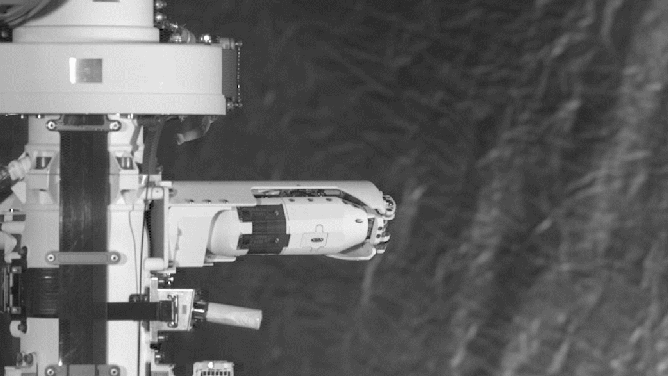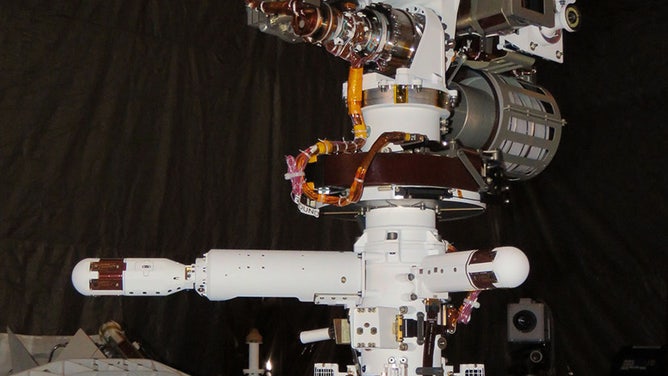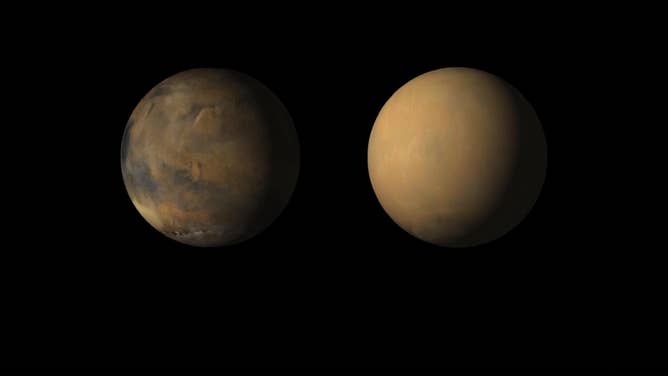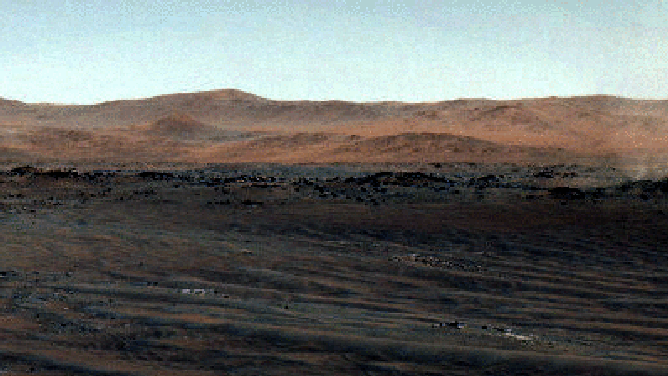NASA’s Mars rover reveals diversity of wild weather on the red planet
A new study based on the Perseverance rover's weather instrument has provided the first detailed weather report on Mars, from temperature swings to dust storms.

File photo: One of two wind sensors springs out of the mast on NASA's Perseverance Mars rover. These sensors are part of the Mars Environmental Dynamics Analyzer (MEDA), the rover's set of weather instrumentation. MEDA was provided to NASA by the Centro de Astrobiología (CAB) at the Instituto Nacional de Técnica Aeroespacial in Madrid, Spain.
(NASA)
Aspiring Mars astronauts can look to NASA’s Perseverance rover to glean what a daily weather forecast might look like as they live and work on the rust-colored world.
The Perseverance rover has been roving on an ancient lake bed of Mars known as the Jezero Crater for over a Martian year, or 687 days on Earth, since landing in February 2021. The rover is a supped-up science machine with instruments, cameras and sensors to search for signs of microbial life.
Percy also has an onboard weather reporter known as MEDA, or the Mars Environmental Dynamics Analyzer.
MEDA was provided to NASA by the Centro de Astrobiología (CAB) at the Instituto Nacional de Técnica Aeroespacial in Madrid, Spain. The instrument's name roughly translated to "give me" in Spanish. As in: "MEDA! Give me the weather, dust and radiation report on Mars," according to NASA.
Located on Percy’s "neck," MEDA samples radiation and aerosols, measures wind speed and direction and detects changes in the Martian atmosphere.

The Mars Environmental Dynamics Analyzer (MEDA) collects atmospheric measurements provides a regular weather report from Jezero Crater on Mars. (Credit: NASA/JPL-Caltech.)
Using the data from the first 250 sols on Mars, scientists with the University of the Basque Country in Madrid have released the most extensive atmospheric and weather report from Mars yet. Their findings were recently published in the scientific journal Nature Geoscience detailing the weather in the Northern Hemisphere from spring to early summer.
Mars experiences four seasons like Earth but the temperature swings from day to night would give you whiplash.
According to the study, the average temperature at the Jezero Crater is around minus 67 degrees Fahrenheit (minus 55 Celsius), with a difference between day and night of around 50 to 60 degrees.
Temperatures typically peak around noon and are convective as air rises and falls, settling around the evening, according to the study.
"These subside before sunset and increase again during the break-up of the night-time inversion, suggesting strong nocturnal fluctuations," the study says. "The oscillations are created by turbulent processes in the atmosphere whose characteristics can be investigated by analyzing the spectral power density of temperatures, pressures and winds."
Tracking dust devils and global storms

Side-by-side images shows how the 2018 Mars global dust storm enveloped the Red Planet, courtesy of the Mars Color Imager (MARCI) camera onboard NASA's Mars Reconnaissance Orbiter (MRO).
(NASA)
The Mars dust season begins in the spring, and dust storms can start in one area and then cover the entire globe.
MEDA has been able to collect data on storms happening thousands of kilometers away and directly around the rover.
According to the University of the Basque Country, a January 2022 dust storm led to dramatic changes in temperature and pressure, along with wind gusts kicking up dust and damaging a sensor.
NASA said the massive dust storm was nearly twice the size of the U.S. and caused some Martian robotic explorers to pause normal activities.
Dust storms can be fatal for Mars robots. The 2018 dust storm pictured above enveloped the whole planet and caused NASA's Opportunity rover to lose contact with Earth.
Perseverance's weather instrument is helping atmospheric scientists to better understand the global and local forecast on Mars.
"MEDA is providing high-precision, meteorological measurements enabling the Martian atmosphere to be characterized, for the first time, from local scales at distances of a few meters, as well as on the global scale of the planet by collecting information on what is happening thousands of kilometers away. All this will lead to a better understanding of the Martian climate and improve the predictive models we use," study co-author Agustín Sánchez-Lavega said.

NASA’s Perseverance Mars rover used one of its navigation cameras to capture these dust devils swirling across Jezero Crater on July 20, 2021. (Image credit: NASA/JPL-Caltech/SSI)
MEDA sensors have also detected atmospheric activity around the rover produced by swirling vortices known as dust devils. Data from MEDA has helped define the size – up to 100 meters (about 110 yards) in diameter – and the abundance of these whirlwinds.
Not only can Perseverance record atmospheric data, but it can also see and hear the dust devils.
Scientists said the weather reports from Mars help plan Ingenuity helicopter flights and will be essential when NASA and the European Space Agency retrieve samples collected by Perseverance in the future.